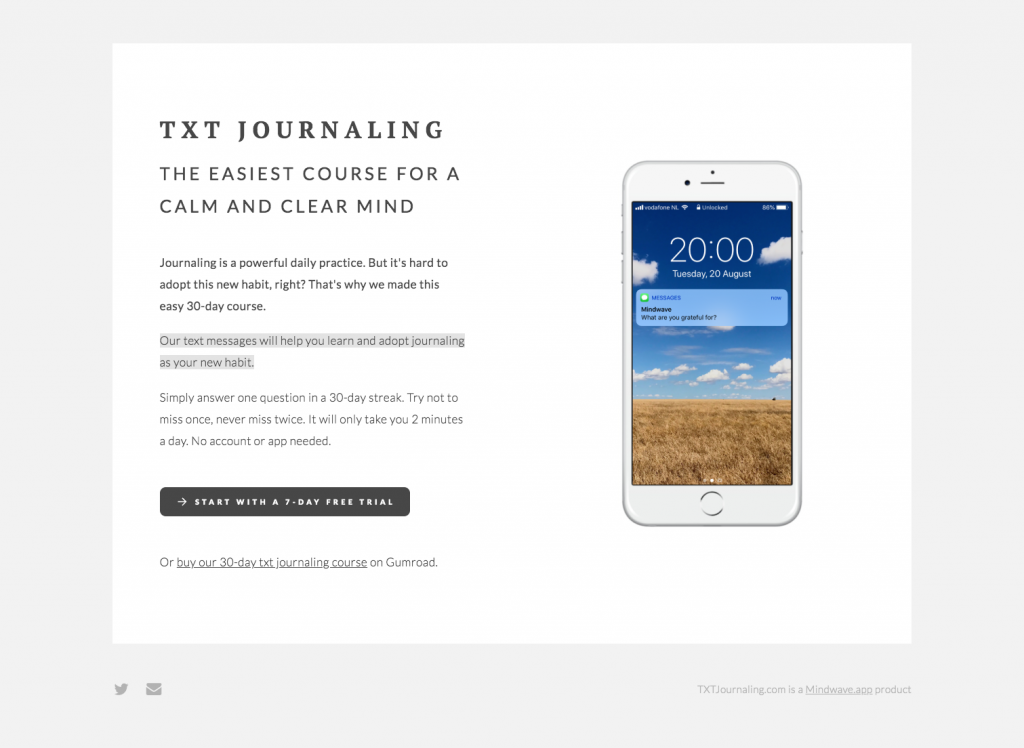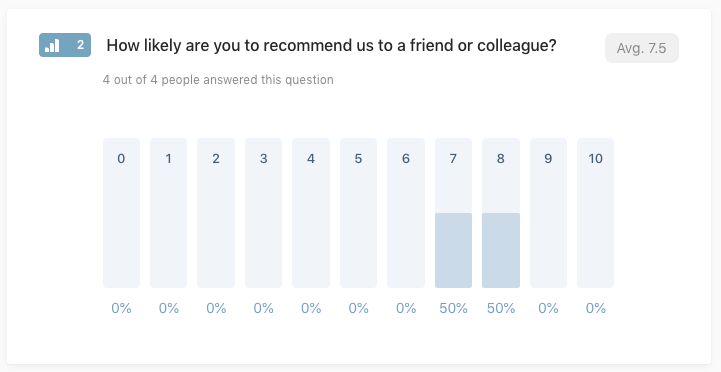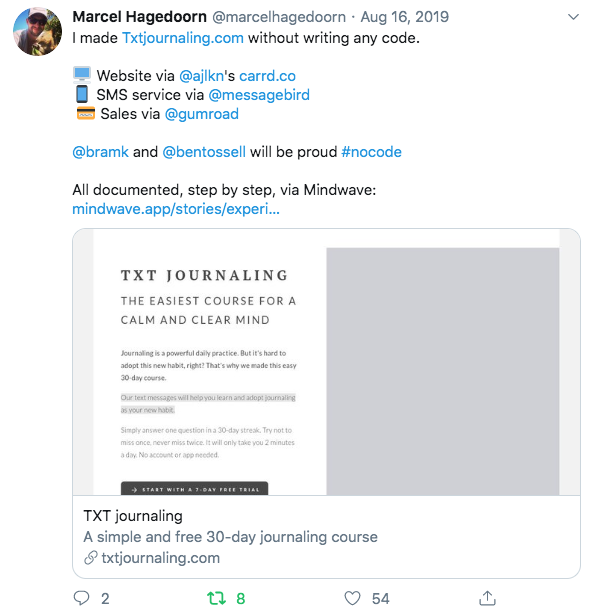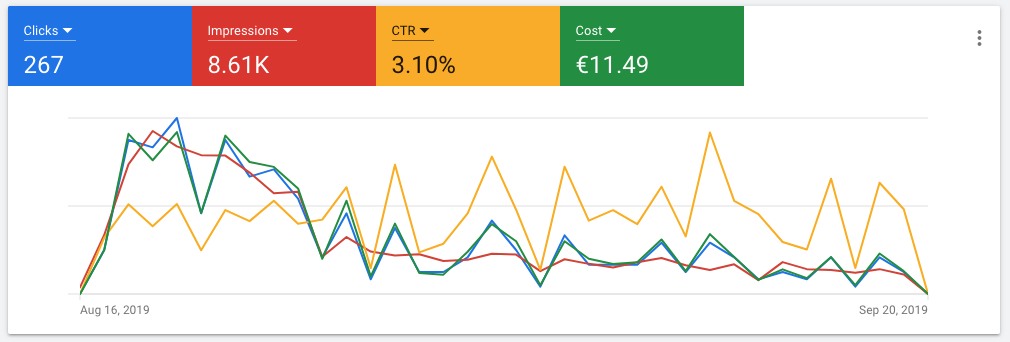Last year, I built an SMS journaling course. A neat ‘no-code’ experiment to make the easiest, most simple journaling course thinkable.
This is what I learned and discovered.
No-code projects are fun

I had so much fun building the course on my own. I’ve made some websites in WordPress before (like Daphnedevries.nl) but not a complete product.
I used carrd.co for the website. Carrd.co is an easy, simple one-page website tool made by the highly respected Product Maker @Ajlkn. AJ is not only building an excellent product, but he is also sharing his progress in this Twitter Thread since 2016. A big inspiration for Mindwave and me.
Then I made an account in Messagebird to build the actual course. I had to try several options to find the best way to set-up this course. I never managed to fully automate the course, because Messagebird doesn’t support Timezones the way I want to use it.
After a while, I decided to integrate Gumroad in the product. Gumroad helps creators with a super simple e-commerce solution. Sahil Lavingia is another respected product maker/startup founder. He managed to transform Gumroad from a scale-up to a bootstrapped company. His incredible journey is a great inspiration for every bootstrapper.
So, I made a site, a service, and a (sort of) integrated payment service all by myself. Not bad for a non-coder. I loved working on the product, the site, the examples, the beta test, and everything related to it.
This is not going to be my last no-code product!
Beta testers not super enthusiastic
I started the pilot (or beta, whatever) with 10 participants. Three of them didn’t start the course at all. After Sign up, they never participated or ‘got the course in their system.’ Seven participants actually participated in the SMS course. Five of them got the 30-day course, two of them got the 8-day trial + Gumroad follow-up.
I did a small survey, in TypeForm, to get some feedback from my participants. Four of the seven filled in the survey, the other 3 mailed, texted, or called me for their feedback.

In general, the results quite ok. If I were still on Highschool, I would be thrilled with 7’s and 8’s. But for me, this was a sign the course was nowhere good enough. Especially if it should be a lead generating course for Mindwave.
Next to this NPS question, I also asked them to explain why. I got responses like:
- It’s a helpful service, but I wouldn’t pay for it.
- SMS isn’t a better alternative for email or a (native) app.
- Keep experimenting. It’s inspiring.
So, a lot of work needed to be done to make the course more appealing. That isn’t surprising. Who is building a product that gains all 9’s and 10’s from the start?
Not all products are launch worthy
Launching as a marketing strategy. It’s something that I learned from Pieter Level’s MakeBook. TXTjournaling could have been one of the (many) products to gain appearance, reach, and traffic for my main product: Mindwave.
So first, I signed Txtjournaling.com up for Mark Kohlbrugge’s BetaList. I didn’t pay for the ‘skip the line’ part and went for the free listing. But, I didn’t make it to the site. It didn’t get selected and featured. It probably didn’t meet Betalist’s criteria.
A course is probably not Techy enough, right? Right!
That got confirmed by Bram Kanstein, creator of the amazing NoCodemvp Course. He told me courses are excluded from ProductHunt launches as well. So he found alternative ways to launch his product, as he also launched Road to Scale and My Startup name in the same period.
So, my ‘launch’ was this Twitter post. 54 Likes and 8 RT’s isn’t something I experience daily ?. So It helped to mention the services I used to build this course.

Experiment with Google Ads
I got some traction from twitter. But I wanted to test the site/service with more leads. So I made a Google Ads campaign and targeted people who were looking for a Journaling Course (duh 😉 or How to Journal.
It’s quite easy to set up a Google Ads campaign to test with real users. I’m going to use Google Ads for Mindwave as well. Not as a marketing machine, but as an affordable testing service.

After 267 clicks, no engagement, no trials, and no purchases, I canceled the Ads campaign. Another clue that the site/service isn’t good enough. Especially since the CTR (3.1%) wasn’t that bad at all!
Other conclusions

What are leads worth to me
So If the course isn’t good enough to sell, what about making it a free 30-day course?
Well, I calculated that it would cost me about € 2,35 per participant (CPL?). That’s a lot of money per lead. I can use Google Ads for around € 0,50 per lead. So that’s not an option!
Not fully automated
TXTjournaling wasn’t fully automated yet. I still had to do manual work if there was a new participant. I was thinking of using Zapier and AirTable to make some improvements, but I will save those amazing no-code tools for the next project.
Documenting isn’t easy
It isn’t that easy to document your progress at all. It took me some time to write this article. I already made my decision to stop with the course. Why bother documenting it, when there are new things that are on your mind, right? That’s why documenting your progress is hard. It feels like extra work. What to gain from it? How could Mindwave make me write/document this story easier?
Another site to market
A multi-product launch could be a great way to promote the main product. But you’ll have another product to improve, to maintain, and to market too. It’s already a big challenge to build a sustainable Mindwave. Would it be wise to split focus atm?
In conclusion, TXTjournaling was a great experiment. I had my fun, I learned a lot, I got great insights to improve Mindwave, and some ideas to build other no-code products.
Although the course just wasn’t good enough, I would still call the experiment successful. Plus, experiments are temporary by default. Otherwise, they wouldn’t be called an experiment.
So now, let’s kill it.
